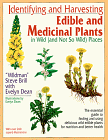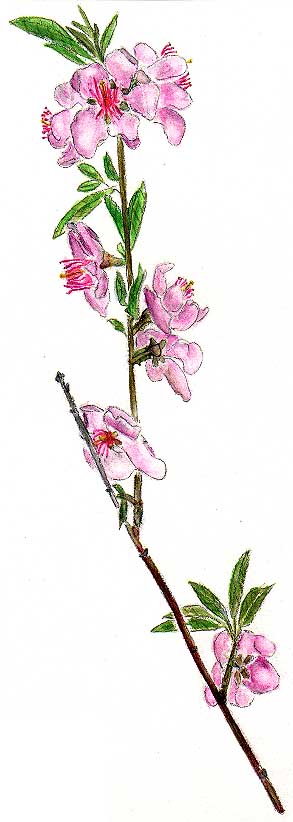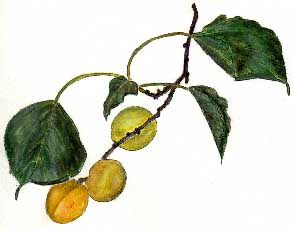|
|
 Identifying and Harvesting Edible and Medicinal Plants in
Wild (and Not So Wild) Places Identifying and Harvesting Edible and Medicinal Plants in
Wild (and Not So Wild) PlacesBook Excerpt: PEACH
AND NECTARINE
(Prunus persica)
By "Wildman" Steve Brill
The peach is a small tree with slender, curving
branches. The finely toothed, narrow, curving,
lance-shaped leaves are 3-5" long, tapering to a sharp
point. The five-petaled, radially-symmetrical, pink
flowers are 1/2—2" across, appearing in early spring,
before the leaves open.
The wild peach is like the commercial version, yellow
with red blush, downy skin, and gently grooved. It
ripens from mid- to late summer. Like all members its
genus, there is one large pit. The inner kernel closely
resembles an almond—a close relative without the
fleshy fruit. The peach has been cultivated for
millennia in Europe and Asia. Peach sculptures and
porcelains date back to ancient China, when the fruit
was cared for under glass.
Peaches grow throughout the United States, wherever
they've escaped cultivation. Soon after purchasing my
first wild food field guide, I explored an overgrown
empty lot to look for asparagus. There was neither
asparagus nor anything else I could identify, although
subsequent explorations turned up a peach tree. Later
on, I was amazed to find others in out-of-the-way
places in city parks, in fields, thickets, and disturbed
areas such as roadsides. People eating peaches
probably threw away the seeds, which grow quite
readily.
Unfortunately the fruits I find are usually infested with
insects. I had better luck with wild nectarines. I was
leading a tour in Central Park late one summer, when
I spotted a peach tree. After announcing my find, a
student reached under the foliage and pulled out a
delicious, ripe nectarine. There was plenty for
everyone.
In actuality, nectarines are smooth-skinned peaches,
and peaches are fuzzy nectarines. That’s why I was
fooled. The foliage is identical. A genetic mutation,
like that which creates albinos, makes the difference.
Sometimes the two fruits grow on the same tree, and
you may even find fruits that are half nectarine and
half peach. The popular idea that nectarines are
hybrids of peaches and plums is simply erroneous.
These wild nectarines were smaller and less juicy than
the peaches, but these were sweet and delicious, with
no insects. This is the only nectarine tree I’ve ever
found. It taught me that wherever you live, nature is
full of surprises.
Soon after, I found another unexpected close relative
of peaches and nectarines, in an overgrown field near
the seashore—a wild apricot tree (Prunus armeniaca).
It’s a small tree, with medium-sized, simple, alternate,
wedge-shaped, finely-toothed leaves. Apricot pits litter
the ground under it all year, and the fruit is identical to
commercial apricots (but much tastier), so it’s easy to
identify. Apricots aren’t supposed to grow wild in the
North (the blossoms open so early in the spring,
they’re vulnerable to frost), but they don’t seem to
realize it. I don’t know how common they are, but
keep your eyes open for them. You may find them
escaped from cultivation in sandy fields and thickets
across the country, where apricot-eating people tossed
away their pits.

Wild Apricot Blossoms - watercolor pencils - "Wildman"

Wild Apricots - watercolor pencils -
"Wildman"
Peaches contain large quantities of beta-carotene and
potassium, as well as calcium, phosphorous, and
vitamin C. Virtually everyone eats or knows how to
prepare peaches, but few people know that the peach
is an important medicinal plant. Peach leaf infusion or
peach bark decoction is a demulcent—soothing to the
mucus membranes. Herbalists use it for stomachaches
and digestive disorders, and to clear out the intestines
and the kidneys. It also has sedative, diuretic, and
laxative properties.
Peach pit decoction is also very soothing and
stimulating to the stomach—a good stomach tonic to
take before or during meals—to stimulate enzyme
activity and relax the nervous system. Caution: Don’t
eat the raw kernel inside the pit. It contains
hydrocyanic acid (see apricot), a gastric irritant
(destroyed by heat) which could potentially release
toxic cyanide.
________________________________________________
Click here to visit Steve's Web Site |
